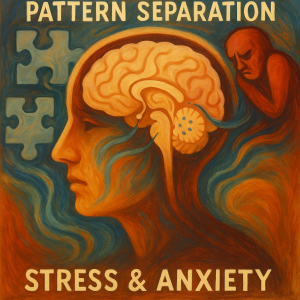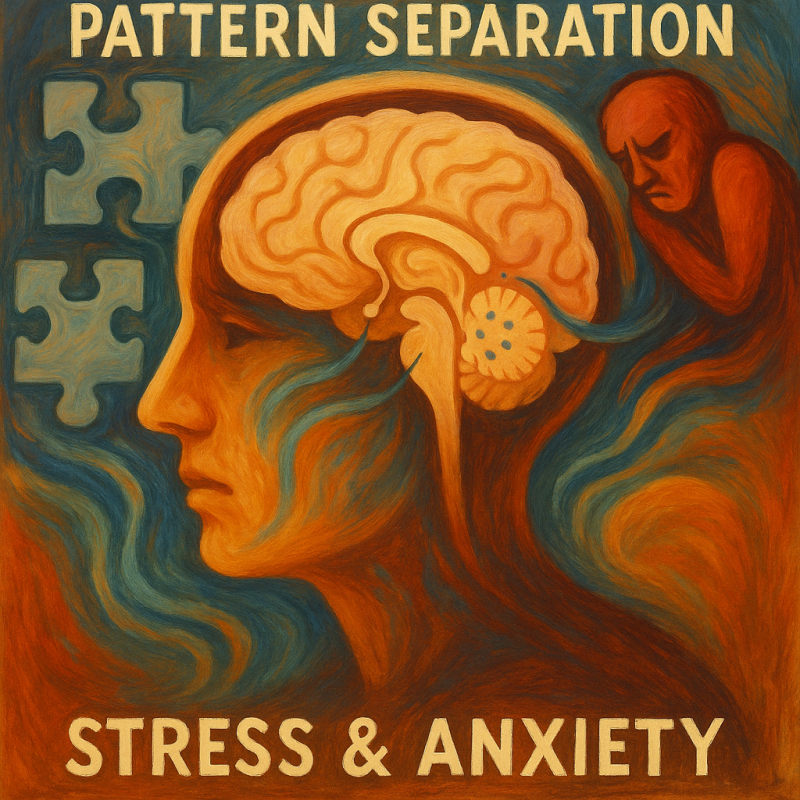
Figure 1. Impact of stress and anxiety on pattern separation.
Created by Sharleen Mtesa. The image shows a brain with disrupted signals and emotional shadows, symbolizing how stress affects memory. Puzzle pieces and swirls represent confusion, while the background figure reflects emotional burden.
Have you ever noticed how certain memories, especially those tied to fear, stress, or strong emotions, seem impossible to forget? These moments, whether terrifying, traumatic, or deeply moving, often stay with us for life. Scientists have found that a small part of the brain called the dentate gyrus (DG) plays a major role in this [1]. The DG, located in the hippocampus, processes incoming information and helps determine which memories are stored long-term, particularly those linked to strong emotions.
But memory isn’t just about storing emotional experiences, it’s also about keeping them distinct. When stressful or emotional events are similar, how does the brain prevent confusion between them?
Therefore, one key function of the DG is pattern separation, the brain’s ability to transform similar experiences into distinct, non-overlapping memories.

Figure 2. The location of the dentate gyrus in the brain.
This image shows where the dentate gyrus is located inside the hippocampus, a part of the brain involved in memory and emotion.[2]
How the Brain Keeps Stressful Memories Separate
According to the paper “Making memories of stressful events: a journey along epigenetic, gene transcription, and signaling pathways”, the DG achieves pattern separation through a very selective process. Only a small number of neurons in the DG become active during a stressful experience. This phenomenon, called sparse activation[1], helps keep memories sharp and distinct.
But this selectivity isn’t random, it’s carefully controlled by molecular switches within the brain cells. One of the most important switches is a histone tag called H3S10p-K14ac. Think of it like a key that unlocks tightly packed DNA, allowing important memory-related genes, like c-Fos and Egr-1, to be turned on. Without this tag, these genes remain inactive.[1]
Even though stress activates many parts of the brain, only DG neurons with this specific histone tag begin recording the memory. This ensures that the brain focuses its response on just a few key cells, helping to preserve the distinctiveness of each memory.
How the Dentate Gyrus Works Its Memory Magic.
The DG has some cool tricks to keep your memories sharp and organized:
1. Sparse Coding
- Only a small group of neurons fire for each experience.
- ➡️ Prevents similar memories from overlapping.
- Example: Meeting two people with similar voices? DG helps you tell them apart.
2. Input from the Entorhinal Cortex (EC)
- EC sends sensory + spatial data to the DG.
- DG reshapes it and passes it to the hippocampus.
- Ensures detailed, clear memory storage.
3. Inhibitory Microcircuits
- GABAergic interneurons = your brain’s memory traffic cops.
- Prevents too many neurons from firing at once.
- Example: Helps you remember where you actually parked today, not yesterday.
4. Neurogenesis = Fresh Memory Power
- DG keeps growing new neurons, even in adulthood.
- These newbies help make fresh, flexible, and distinct memories.
- Keeps your brain adaptable, not stuck in the past.

Figure 3. Simplified Flow of Information in the Hippocampal Formation.
This figure shows how sensory input from cortical association areas is processed by the parahippocampal and perirhinal cortices, then transmitted to the entorhinal cortex, which relays it to the hippocampus. Within the hippocampus, the dentate gyrus (DG) acts as the initial processing stage, playing a key role in pattern separation, transforming similar inputs into distinct memory representations before passing information to CA3, CA1, and the subiculum. [3]
How Stress & Anxiety Mess With the DG’s Memory Magic.
Stress doesn’t just make you feel awful, it actually affects how your brain remembers.
- Stress Hurts Neurogenesis
- DG produces new brain cells throughout life (neurogenesis).
- Chronic stress = high cortisol (a hormone the body releases under stress) = fewer new neurons. [4]
- Fewer neurons → DG can’t keep memories separate → confusion & memory blending.
2. HPA Axis Overdrive Weakens DG
- When stress continues for too long, the HPA axis(the body’s stress response system) stays overactive, keeping stress hormones high. [5]
- High cortisol levels weaken connections between neurons in the DG.
- ➡️ This makes it harder for the brain to separate new experiences from past ones
- Leads to anxiety, fear, and biased memory recall.
-
Pattern Completion Takes Over
- DG usually favors pattern separation.
- Under stress, it shifts to pattern completion (retrieving old memories based on partial cues).
- What that looks like:
- Fear Overgeneralization: Mistaking safe situations for dangerous ones.
- Exaggerated Emotional Reactions: Past trauma colors present experiences.
-
Memory Interference: Past vs. Present
- DG normally prevents interference between old and new memories.
- Stress disrupts that filter:
- Past memories bleed into new ones.
- Makes it hard to feel safe even when you are. [6]
How to Boost DG Function & Beat Stress
Want to keep your DG happy and your memories sharp? Try these:
- Exercise: Boosts neurogenesis + lowers cortisol
- Mindfulness & Meditation: Calms your stress response system
- Cognitive Behavioral Therapy (CBT): Helps reframe overgeneralized fears
- SSRIs/Antidepressants: Improve memory-related brain plasticity
Final Thoughts: Protecting Your Brain’s Memory Filter
The dentate gyrus may be small, but its role in shaping how we process and separate emotional memories is huge. When working well, it helps us distinguish the past from the present, keeping our memories organized and our reactions in check.
But chronic stress and anxiety can disrupt this process, blurring lines between memories, fueling fear, and making it harder to feel safe in the moment. The good news? The DG is flexible and responsive. With habits like exercise, mindfulness, therapy, and proper treatment, we can support brain health and improve memory clarity.
Because memory isn’t just about holding on, it’s about understanding, adapting, and moving forward.
Footnotes:
[1] Reul J. M. (2014). Making memories of stressful events: a journey along epigenetic, gene transcription, and signaling pathways. Frontiers in psychiatry, 5, 5. https://doi.org/10.3389/fpsyt.2014.00005
[2] Centre of Excellence for Early Childhood Development. (2008, December 5). Glossary – Brain. Encyclopedia on Early Childhood Development. https://www.child-encyclopedia.com/sites/default/files/docs/glossaire/Glossary_Brain_DG.pdf
[3] Weilbächer, R., & Gluth, S. (2016). The interplay of hippocampus and ventromedial prefrontal cortex in memory-based decision making. Brain Sciences, 7(1), 4. https://doi.org/10.3390/brainsci7010004
[4] Schoenfeld, T. J., & Gould, E. (2012). Stress, stress hormones, and adult neurogenesis. Experimental neurology, 233(1), 12–21. https://doi.org/10.1016/j.expneurol.2011.01.008
[5] Lee, J. W., & Jung, M. W. (2017). Separation or binding? Role of the dentate gyrus in hippocampal mnemonic processing. Neuroscience & Biobehavioral Reviews, 75, 183-194. https://doi.org/10.1016/j.neubiorev.2017.01.049
[6] Kim, E. J., Pellman, B., & Kim, J. J. (2015). Stress effects on the hippocampus: a critical review. Learning & memory (Cold Spring Harbor, N.Y.), 22(9), 411–416. https://doi.org/10.1101/lm.037291.114
